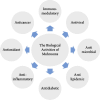Exploring the Phytochemical Compositions, Antioxidant Activity, and Nutritional Potentials of Edible and Medicinal Mushrooms
- PMID: 38841191
- PMCID: PMC11152763
- DOI: 10.1155/2024/6660423
Exploring the Phytochemical Compositions, Antioxidant Activity, and Nutritional Potentials of Edible and Medicinal Mushrooms
Abstract
Mushrooms are a valuable source of food and medicine that have been used for centuries in various cultures. They contain a variety of phytochemicals, such as terpenoids and polysaccharides, that exhibit diverse biological activities, such as antioxidant, anti-inflammatory, anticancer, antimicrobial, immunomodulatory, and antidiabetic effects. However, mushroom's phytochemical composition and bioactivity vary depending on their species, cultivation conditions, processing methods, and extraction techniques. Therefore, using reliable analytical methods and standardized protocols is important for systematically evaluating the quality and quantity of mushroom phytochemicals and their therapeutic potential. This review provides a bibliometric analysis of the recent literature on biological activities, highlights trends in the field, and highlights the countries and journals with the highest contribution. It also discusses the nutritional value of the total content of phenolic and other phytochemicals in some species of mushrooms.
Copyright © 2024 Mohammed Al Qutaibi and Suresh R. Kagne.
Conflict of interest statement
The authors declare that there are no conflicts of interest.
Figures





Similar articles
-
Bioactive Phytochemical Constituents of Wild Edible Mushrooms from Southeast Asia.Molecules. 2020 Apr 23;25(8):1972. doi: 10.3390/molecules25081972. Molecules. 2020. PMID: 32340227 Free PMC article. Review.
-
Immunomodulatory Effects of Edible and Medicinal Mushrooms and Their Bioactive Immunoregulatory Products.J Fungi (Basel). 2020 Nov 8;6(4):269. doi: 10.3390/jof6040269. J Fungi (Basel). 2020. PMID: 33171663 Free PMC article. Review.
-
An insight into the nutritional and medicinal value of edible mushrooms: A natural treasury for human health.J Biotechnol. 2024 Feb 10;381:86-99. doi: 10.1016/j.jbiotec.2023.12.014. Epub 2024 Jan 3. J Biotechnol. 2024. PMID: 38181980 Review.
-
The Effect of Edible Mushroom on Health and Their Biochemistry.Int J Microbiol. 2022 Mar 23;2022:8744788. doi: 10.1155/2022/8744788. eCollection 2022. Int J Microbiol. 2022. PMID: 35369040 Free PMC article. Review.
-
Submerged cultivation and phytochemical analysis of medicinal mushrooms (Trametes sp.).Front Fungal Biol. 2024 Jun 11;5:1414349. doi: 10.3389/ffunb.2024.1414349. eCollection 2024. Front Fungal Biol. 2024. PMID: 38919599 Free PMC article.
Cited by
-
A Comprehensive Review of the Diversity of Fungal Secondary Metabolites and Their Emerging Applications in Healthcare and Environment.Mycobiology. 2024 Dec 3;52(6):335-387. doi: 10.1080/12298093.2024.2416736. eCollection 2024. Mycobiology. 2024. PMID: 39845176 Free PMC article. Review.
-
HPLC based identification of phenolics and biological activities in Elaphomyces mushroom extracts.Sci Rep. 2025 Jul 26;15(1):27182. doi: 10.1038/s41598-025-07036-z. Sci Rep. 2025. PMID: 40715160 Free PMC article.
-
Supporting Neurologic Health with Mushroom Nutrition.Nutrients. 2025 May 2;17(9):1568. doi: 10.3390/nu17091568. Nutrients. 2025. PMID: 40362877 Free PMC article. Review.
-
Biological Effects of Polysaccharides from Bovistella utriformis as Cytotoxic, Antioxidant, and Antihyperglycemic Agents: In Vitro and In Vivo Studies.Pharmaceutics. 2025 Mar 5;17(3):335. doi: 10.3390/pharmaceutics17030335. Pharmaceutics. 2025. PMID: 40142999 Free PMC article.
-
Optimizing Ultrasonic-Assisted Extraction Process of Paralepista flaccida: A Comparative Study of Antioxidant, Anticholinesterase, and Antiproliferative Activities via Response Surface Methodology and Artificial Neural Network Modeling.Molecules. 2025 Aug 8;30(16):3317. doi: 10.3390/molecules30163317. Molecules. 2025. PMID: 40871471 Free PMC article.
References
-
- Chang S. T., Wasser S. P. Oxford Research Encyclopedia of Environmental Science . 2017. The cultivation and environmental impact of mushrooms.
-
- Pavlovna V., Gordon Wasson R. MUSHROOMS RUSSIA AND HISTORY . 1957. http://www.NewAlexandria.org/
-
- Hawksworth D. L. The magnitude of fungal diversity: the 1.5 million species estimate revisited. Mycological Research . 2001;105(12):1422–1432. doi: 10.1017/s0953756201004725. - DOI
Publication types
LinkOut - more resources
Full Text Sources

